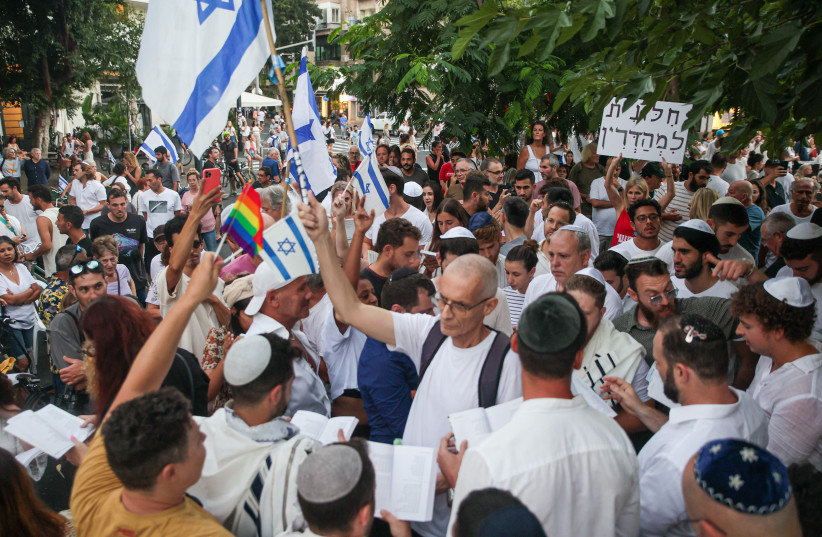Like many of my fellow journalists, writing about the year of hell we have endured, marked by the October 7 anniversary, felt overwhelming. Yet, as we emerge from Yom Kippur in Israel, I have gained a sense of clarity about what was clearly a pivotal moment in Jewish history.
On October 3 last year, I wrote an op-ed titled “We should all be ashamed of what happened last Yom Kippur in Tel Aviv.” A year of intense political strife over judicial reform and our extremist leadership had turned daily life in Israel unbearably toxic. Conversations had grown increasingly divisive, and the discourse between opposing sides made it feel as though Israel was teetering on the brink of civil war.
This culminated in the desecration of Yom Kippur, the holiest day of the Jewish calendar, when fights broke out between religious and secular in Tel Aviv over a mechitza – the partition used in traditional Orthodox prayers. The courts, municipalities, and laws concerning these barriers were at the heart of the conflict.
Secular communities viewed the presence of a mechitza in public spaces as an infringement on their liberal values, believing such practices belonged strictly within synagogues. Meanwhile, others, such as myself, cherished the outdoor traditional prayers, which beautifully united secular and religious Jews.
The mechitza became a symbol of a much deeper conflict, a year of internal strife that exposed the fractures in Israeli society. Protesters disrupted Orthodox services, harassing worshipers, desecrating machzorim (festival prayer books), and driving scooters and bikes through the congregations to halt the prayers.


It was heartbreaking to witness this chaos on Yom Kippur, a day meant for reflection and repentance, devolve into one of the most shameful moments in Jewish history. I never imagined that Israel could be a place where Jews would chase other Jews from public spaces into synagogues. It embodied sinat hinam (baseless hatred) among Jews, a destructive force that has led our people to danger and ruin throughout history.
Just a week and a half later, Hamas carried out the October 7 massacre.
Simchat Torah, usually filled with joyous dancing and singing in celebration of the Torah, was transformed into the scene of the worst slaughter of Jews since the Holocaust.
The biblical parallels are too overwhelming to ignore.
The same Dizengoff Square in Tel Aviv, which had been the epicenter of the Yom Kippur mechitza conflict, was transformed overnight into a humanitarian hub where both religious and secular Israelis came together to gather supplies for soldiers.
As the year progressed, I began to view the events of Yom Kippur 2023 through a different lens. I now believe that the threat facing the Jewish people is more insidious than internal division alone. Throughout our history, we have learned that baseless hatred led to the destruction of Israel and the Temples.
But I recently heard a profound insight from American-Israeli journalist Yossi Klein Halevi: Baseless hatred was not the cause, but rather the consequence of weak and corrupt Jewish leadership. The corruption of the priesthood, monarchy, and political zealots drove the destruction of the Second Temple and the exile from Jerusalem. As Klein Halevi eloquently put it, “Sinat hinam, hatred among Jews, was the consequence. It wasn’t the cause.”
2023 leading up to October 7
THIS INSIGHT captures the essence of 2023 leading up to October 7. During the height of the judicial reform protests, many Israelis sought second passports, fearing that the government’s policies could provoke mass emigration. Young liberal Israelis, the backbone of our Start-Up Nation, worried that these policies would push Israel toward becoming an illiberal regime.
Regardless of where one stands politically, one cannot ignore this government’s role in fostering civil discord and its catastrophic security failure on October 7. Only 20% of Israelis today say they trust the current leadership. Even many initial government and judicial reform supporters now admit that this leadership failed all of us. The Hamas massacre was not only the fault of the security apparatus but also of a government that should have implemented policies to ensure civilian safety.
It failed long before October 7 by pushing divisive and controversial policies that fractured our society. It was unable to unify the nation and, instead, led us to the edge of civil war. And on October 7, when Hamas breached our borders and slaughtered 1,200 Israelis – babies, elderly, families – it failed us again. For many, the heartbreaking words of hostage families have revealed a leadership more focused on politics than on bringing their loved ones home from Hamas captivity.
This Yom Kippur, at an outdoor service on the beach in Tel Aviv, thousands of Israelis from all walks of life and levels of religiosity stood together as the sun set in a blaze of orange and gold. We prayed for the protection of our soldiers, for the release of the hostages, and for the peace and safety of our nation. We all, secular, religious, conservative, and liberal, listened to the shofar sound and sang “Hatikvah,” our national anthem.
Amid all the division and loss of the past year, this Yom Kippur reminded me that even in our darkest hours, our survival depends on uniting as one people – and that the spirit of the Israeli people is far stronger than any leadership.
The writer is a social media activist with over 10 years of experience working for Israeli and Jewish causes and cause-based NGOs. She is a co-founder and COO of Social Lite Creative, a digital marketing firm specializing in geopolitics.
